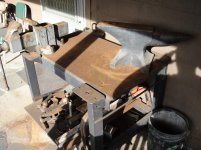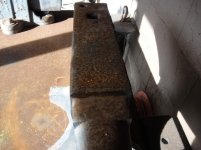Buddies have told me that rail anvils are nice cheap, but not advisable. As the rail road cars roll over the rails, the steel rails become work-hardened. That seems good until you realize that also makes the steel brittle and liable to chip with hammer blows and fly off bits of it- face etc.,
Usually a want ad booklet is a place to buy an old anvil- used to be a dollar a pound, more now. There is nothing wrong with an old anvil I have a 189 ib anvil from about 1840 and a Peter Wright 98lb anvil from 1880 or so. Both are excellent. The top face can always be refinished - milled slowly or ground very carefully and kept cool so as not to lose the temper.
Mechanic's garages often have anvils they beat on. Old barns, auctions, and Ebay are also places to look. I would never use a sledge hammer on an anvil. Maybe a 6 lb hammer with a drop stroke- but never the over the shoulder stoke like you use driving fence posts or splitting wood. -Substitute a rock in the ground or a hard old stump.
If you have a good heat on the piece, you don't need to kill it to bend it. I have straightened the lift arm on my TC 30 with a sledge cold- - hitting it against the ground on a 2x6 with an over the shoulder blow- 5-6xs.
Check out Centaur Forge online- (see what it is, then find it used!).
Centaur Forge, your full service farrier & blacksmith supply company
It is not that hard to make a forge & blower. Plans are everywhere.
Don't buy new unless you like the convenience. Great way to visit tool barns!
You'll come to appreciate the "drop forged" parts on old machinery as you come to understand blacksmithing- (iron work) (farrier does horse).
HF carries junk for anvils.


